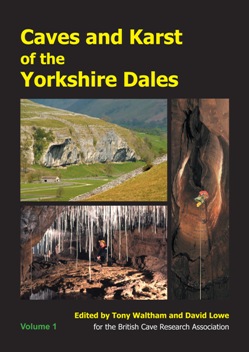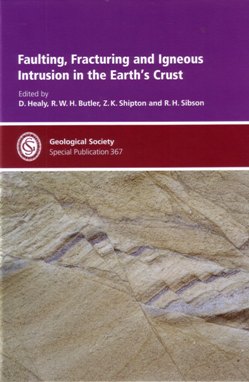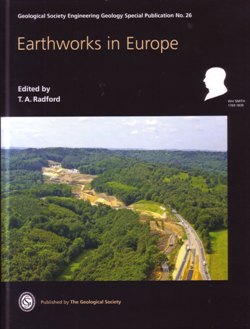 CAVES AND KARST OF THE YORKSHIRE DALES
CAVES AND KARST OF THE YORKSHIRE DALES
This magnificent book on the classic Carboniferous Limestone landscape of North West Yorkshire is a much revised and extended version of one first published nearly 40 years ago. The area covered is largely that of the Yorkshire Dales National Park. So much has happened in Quaternary studies in the last 40 years that a complete rewrite has become necessary. In particular isotope dating of various features (U/Th, C-14, Al/Be, Cl, palaeomagnetism and luminescence methods), using speleothem samples (stalagmites) as well as new geomorphological interpretations, has enabled the authors to correlate many aspects of the Yorkshire Dales and caves with other Quaternary sequences. The relationship to the climatic fluctuations revealed by ocean-floor oxygen isotopes shows that the Yorkshire Dales are much more significant in Britain’s Pleistocene history than previously recognised.
Its chapters have been written by 20 specialists, covering basic geology (with updated stratigraphy), glaciation and Quaternary evolution, and karst geomorphology. Discussion of cave geomorphology emphasizes the transition from inception along geological “weaknesses” such as bedding planes, shale partings, joints and faults, to submerged phreatic passages and their development into vadose caves above falling water-tables. Together, these provide a basis for correlating subterranean and surface features.
The volume continues with a discussion of the limestone hydrology. Palaeoclimatic deductions have also been derived from a study of stalagmites. The last five chapters look at Holocene environments, subterranean biology, bats, cave palaeontology and cave archaeology. The last two provide a useful overview of the occupation of Northern England by animals and humans.
These new studies have extended the timescale for karst development back into the early Pleistocene, with the cover of Upper Carboniferous strata being progressively stripped back to expose the limestone scenery now regarded as fluvio-glacial karst. Reconstruction of the geology in early Pleistocene times yields a concept of the former extent of the Yoredale and Millstone Grit cover, with progressive exposure of the limestone. The history of modification by successive glacial advances and fluvial effects in interglacials can now be interpreted.
This review volume is very well presented with numerous maps, diagrams and photographs, almost all in colour. It should be essential reading for anyone leading the many field classes and excursions to the Ingleton and Malham areas. The book is the first of two, and the second volume will cover individual cave systems such as Gaping Gill and Stump Cross Caverns.
Reviewed by Trevor Ford
CAVES AND KARST OF THE YORKSHIRE DALES
TONY WALTHAM & DAVID LOWE (Eds) March 2013 Published by: British Cave Research Association. (The Old Methodist Chapel, Great Hucklow, Buxton, SK17 8RG). W:
www.bcra.org.uk/bookshop/index.html. A4, 265 pages, 165 maps and graphics, 354 photographs. ISBN 978-0-900265-46-4 (Sbk). List price: £25.00.
 Faulting, Fracturing and Igneous Intrusion
Faulting, Fracturing and Igneous Intrusion
This book is misleadingly named as only one of its 14 papers deals with igneous intrusion and faulting. A better title is that given by the editors to their introductory chapter: ‘Stress, faulting, fracturing and seismicity: the legacy of Ernest Masson Anderson’, especially as the book arose from a conference to mark the 50th anniversary of his death in 1960.
Anderson’s classic 1905 paper on ‘The dynamics of faulting’ is reproduced in facsimile. Anderson brilliantly explained the stresses that produced thrust, wrench, and normal (extensional) faults under isotropic conditions. This book concerns the effects of the ubiquitous anisotropic conditions in the Earth’s crust including variable pore-fluid pressures.
Only four of the papers are singly authored (a rapidly dying type!). Gerbault shows that wall failures around circular magma chambers occur in shear rather than tension unless the pore-fluid pressure in the bedrock cancels the effect of gravity. Sibson considers reverse fault rupturing: competition between non-optimal and optimal fault orientations. Lopez deals with Andersonian and Coulomb stresses in Costa Rica and the fault slip and seismic tendency potential. Healy develops the Law of Effective Stress to incorporate anisotropic poroelasticity and the response of faulted rock to changes in pore-fluid pressure.
Sibson et al. give an excellent account of Andersonian wrench faulting in the 2010−11 Canterbury, NZ, earthquakes; Bistacchi et al. describe non-Andersonian faulting along Alpine phyllosilicate-rich mylonite belts; Tingay et al. similiarly deal with such faults above evaporites in the Nile delta; King et al. consider stress deflections around salt diapirs that pierce overlying Gulf of Mexico deltaic sediments; MacDonald et al. model fault reactivation in the Bight Basin in southern Australia, while Tavani et al. analyse the stresses during thrust-related folding in the Boltaña anticline, Pyrenees and Van Noten unravels the 3D stress state in compressional tectonic inversion at the onset of orogeny in the Ardenne Slate Belt. Main et al. consider the dilatancy-diffusion hypothesis and the flawed search for earthquake predictability.
Overall, this is an excellent and recommended 2012 account of how Andersonian and other factors control faulting and its orientation, with a good spread of geographical and geological situations and modelling. Had it included the outstanding 2012 paper on ‘Granite magma migration and emplacement along thrusts’ (Ferré et al. Int J Earth Sci [Geol Rundsch] 101, 1673−88) it would even have justified its title!
Reviewed by Bernard Elgey Leake
FAULTING, FRACTURING AND IGNEOUS INTRUSION IN THE EARTH’S CRUST
D HEALY, R W H BUTLER, Z K SHIPTON & R H SIBSON (Editors), 2012. GSL Special Publication 367. ISBN 978-1-86239-347-9 (hbk). 253pp List price: £85.00. Fellows’ Price £42.50.
www.geolsoc.org.uk/bookshop
 Earthworks in Europe
Earthworks in Europe
This collection of papers from the Second International Seminar on Earthworks in Europe held in 2009 is a timely update on earthworks. Although earthworks activity in western Europe has moved from construction to maintenance, major new earthworks are underway and planned in eastern countries. The London venue is reflected by the fact that two out of three papers originate in the UK, but it is good to see papers from Czech Republic (two), as well as France, Ireland, Spain and Slovenia.
The book’s 18 papers fall into six categories. There are six on standards and specifications and then two each on asset management, use of natural and recycled materials, slope stabilisation, monitoring and environmental impact. The coverage of each sub-topic is represented by the one or two countries that have presented.
The papers on standards and specification report on the current position in UK, Czech Republic and Spain and so provide a useful current view. These papers include reports on the impact of Eurocode 7, ISSMGE on pavements and national specifications.
Asset and risk management papers present a very clear picture of management of the earthworks infrastructure, but only in the UK.
The monitoring of earthworks is considered in the context of the climate change on slopes. Changes in weather patterns are affecting operating strengths in the earthwork materials, and identification of the impact of these and their monitoring forms the basis of these useful contributions.
Maximisation of the use of natural materials has always been the requirement for designers, but this need becomes ever more acute; reports from Ireland and Slovenia are particularly valuable here. Use of waste materials in earthworks is very topical, and the Czech report on inclusion of industrial wastes such as colliery spoil, ash and slag in earthworks is useful. The UK report on the use of tyre bales illustrates use of a waste to provide a lightweight fill and resolution of a stability problem.
Finally, the measurement of environmental impact of earthworks represents a new aspect of design and these UK reports provide a clear and useful update on this topic.
The papers presented cover a useful range of topical earthworks issues, providing an important statement of current considerations. The representation from around Europe could have been better, but there were external financial restrictions on such activities at the time. This volume is required reading for those needing to get up to date on a range of earthworks design, construction and maintenance topics.
Reviewed by David Norbury
EARTHWORKS IN EUROPE
T A RADFORD (Ed) Engineering Geology Special Publication No 26. Geological Society, London 2012. List price: £75.00; Fellows’ price: £37.50.
www.geolsoc.org.uk/SPE26
 Climate Change: Biological and Human Aspects
Climate Change: Biological and Human Aspects
Read this book and gain a new perspective on climate change. This is above all an interdisciplinary topic, and hard to grasp in all its essentials by those of us brought up in the old-fashioned ‘single discipline’ mode of instruction. Few people have put together in such a compelling and reader-friendly way the full extent of information about climate change and its effects, ranging all the way from changes with geological time to real or potential impacts on human health and welfare and on plant and animal life.
The United Nations Environment Programme (UNEP) cited the first edition of this book (2007) as one of the top climate-change science books of the 21st Century. This second edition has been fully updated and substantially expanded, with major updates on climate impacts on early societies, and on biological impacts; updated graphs on energy production and consumption; new sections on climate thresholds, the Kyoto II conference, and the climate policies of Canada, Australia and NZ; and an Appendix with further thoughts for consideration to stimulate discussion.
This is an educational tome, suitable for the scientifically literate layman, high school and undergraduate students, as well as policy makers. Chapter 1 introduces the topic and its differentiation from weather. Chapter 2 is a useful primer on the modern approaches to measuring past climate change. Chapter 3 takes the reader on a useful tour of climate change in the Earth’s 4.6 billion-year history. In Chapter 4, Cowie focuses on climate’s links to biology, from the Oligocene through the Pleistocene Ice Age and right up to the Holocene.
In Chapter 5 he moves into the Holocene and present climate. Chapter 6 considers current warming and its biological symptoms, ending with a review of possible surprise responses to further global warming. In Chapter 7 we learn about the human ecology of climate change, and the nature and possible manipulation of photosynthesis in the interests of mitigating the problem. In the final Chapter, Cowie documents the development of environmental policy at the international level since the UN Conference on the Human Environment in 1972. He goes on to look at future energy options, and concludes by considering how humans may adapt to further climate change. No matter what we do, Cowie concludes, the biosphere will remain.
This is an invaluable, readable and well-referenced guide to where we are now, how we got here, what is happening now, what may happen next, and what we can do about it.
Reviewed by Colin Summerhayes
CLIMATE CHANGE: BIOLOGICAL AND HUMAN ASPECTS
JONATHAN COWIE. 2nd Edition. Published by Cambridge Univ. Press, 2013. ISBN 978-1-107-60356-1. 440 pp. List price £34.99.
www.cambridge.org.